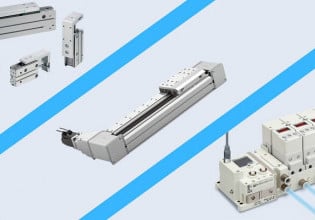Balluff Unveils Inductive Sensor That Detects Ferrous and Non-ferrous Metals at Same Switching Distance
Balluff’s new Factor 1 inductive sensors offer users a single sensor that senses both ferrous and non-ferrous metals at the same switching distance, fit for use in environments with various metal types.
Balluff, known worldwide for its sensing technology, has released the latest in its sensing portfolio, inductive sensors with Balluff's Factor 1 technology. The company’s new sensors can sense both ferrous and non-ferrous metal from the same switching distance, eliminating the need to use more than a single sensor.

The Factor 1 inductive sensor is fit for use in the automotive manufacturing industry. Image used courtesy of Balluff.
Balluff’s Factor 1 Technology
In traditional inductive sensors, electromagnetic fields that behave distinctly with different types of metals are generated. This behavior causes a reduced sensing distance for non-ferrous metals like aluminum. Balluff's Factor 1 sensors, on the other hand, sense with equal sensitivity without considering the composition of the metal to be detected, making it more efficient and versatile than traditional inductive sensors.
With Balluff's Factor 1 technology, users will benefit from a reliable detection range and versatility in all types of metals. By needing only a single sensor for detecting various metal types, Balluff aims to reduce maintenance and downtime needed for multiple sensors. Another key benefit is weld field immunity. The sensors can withstand strong electromagnetic fields in welding or induction hardening systems.
Factor 1 Inductive Sensors
The Factor 1 inductive sensors are available in two styles: barrel and block-style sensors.
Barrel-style Sensors
Balluff's barrel-style inductive sensors come in M8, M12, and M18 and are available in flash and non-flash installation. The sensors are suitable for harsh industrial environments with a brass, nickel-free coated housing material or a PTFE coating. The barrel-style sensors have a 1.5 mm to 8 mm sensing range with the capability of operating in an extended temperature range of -40 °C to 85 °C.

Barrel-type sensors for flash and non-flash installation. Image used courtesy of Balluff.
Block-style Sensor
Balluff's block-style inductive sensors are available in a cuboid size of 40 mm × 40 mm × 66 mm with an innovative PA12 plastic housing. The sensors have a function light visible from a wider angle and can be installed in flash and non-flash installation. The block-style sensors' sensing distance ranges from 20 mm to 40 mm with an ambient temperature range of -25 °C to 70 °C, suitable for various industrial environments.

Block-style sensors for flash and non-flash installation. Image used courtesy of Balluff.
Factor 1 Applications
Balluf's Factor 1 inductive sensors have a wide range of potential applications where there is a need for efficient and accurate metal detection. The inductive sensor can be used in the automotive industry to detect the various metal parts in the assembly line. It can also be used in metalworking where conditions are adverse for traditional inductive sensors, as they can withstand strong electromagnetic fields.
The Factor 1 sensors are also fit for use in general factory automation to identify various metal types. Another potential sensor application is in the food and beverage and pharmaceutical industry to detect contaminants in packaged materials.






